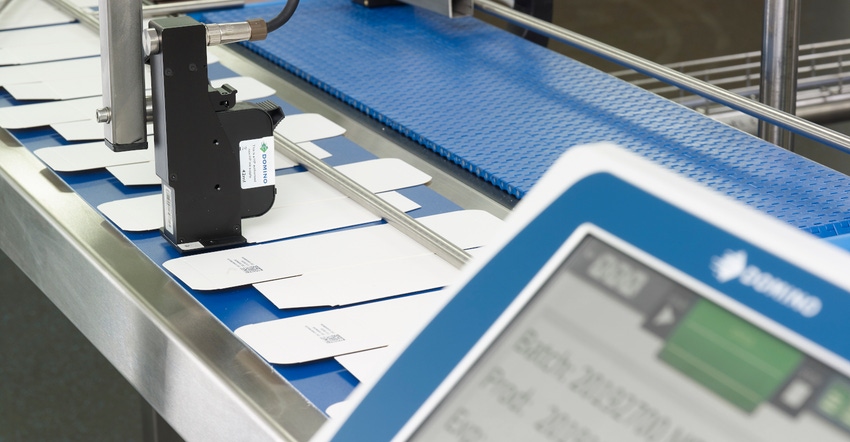4 Steps for Error-Free Coding on Pharmaceutical Packages
Automated package coding solutions, along with code validation systems, play a huge part in ensuring that pharmaceutical production lines are kept error-free and help ensure regulatory compliance.

Validation is a major component of pharmaceutical manufacturing, ranging from production systems, packaging equipment, and computer programs. The packaging printer is a critical element in the validation process, with its output — the label or code — key to compliance.
With today’s just-in-time production, pharmaceutical organizations need robust processes to ensure error-free coding. This is necessary not only to achieve compliance, but to maintain high-speed output.
Here is how pharmaceutical organizations can use automated product coding solutions with code validation to mitigate production risks while maintaining productivity and quality.
Achieving risk-free compliance.
In 2018, more than a million medical devices were recalled because of printing errors on packaging labels. An error in a stray label or Instructions for Use (IFU) can cause a product recall. A trivial issue like a faulty print ribbon, for example, can lead to missing, unreadable, or misinterpreted content. Products pass through various stages of the supply chain and, if undetected at any stage, can multiply the level of risk by tenfold each time. An unidentified product moving through the supply chain can cause regulations to be breached and put patient safety in jeopardy — a risk no organization wants to face.
On production lines that handle multiple products for consumers worldwide, accuracy is crucial. Organizations need to robust mechanisms in place to assure batch integrity. Many organizations don’t realize their printing systems aren’t compliant until regulators come knocking.
So how can you ensure that what is required in the User Requirement Specification (URS) is delivered risk free, without any errors? Follow these four steps.
Step 1: Assess your risk.
The first step is to conduct a thorough risk assessment: A testing strategy will be planned and supported with standardized documentation; and training protocols outlined. A dedicated, GAMP V trained expert will know what is needed to achieve validation in a pharmaceutical production environment, including validating any additional systems’ integration — such as a labeling or enterprise resource planning (ERP) system — and will provide the validation pack to accompany this.
Step 2: Replace manual coding with an automated system.
The second step towards reducing coding or labeling errors is to simplify or reduce the need for manual data entry on production lines by switching to an automated system to coordinate your product labeling.
At the most basic level, by using coding automation and label design software, manufacturers can populate product labels and manage their distribution across multiple printers — reducing the number of touchpoints present on a line, and thereby reducing the chance of errors occurring.
Step 3: Establish good label/code management.
The next step is to establish good label management. With the simple application of Internet of Things (IoT) methodology, you can integrate automated coding solutions and automatically populate labels from a central database and help prevent mislabeled products arising from issues in label creation.
Integrated label management solutions can be anything from a simple barcode scanner set to select data from a Universal Product Code (UPC) or product order, through to full integration with an existing manufacturing execution system (MES) or ERP system — enabling label creation directly from a centralized product database.
Populated labels can then be automatically pushed through to a printer without any manual intervention. This mitigates the risk of errors and helps ensure efficiency on production lines.
Step 4: Integrate automated vision control.
The final step towards error-free coding is in establishing a validation system to ensure that all information on product labels is present, correct, and readable.
Today, high-speed manufacturing environments have made manual inspection nearly impossible — integrated vision control systems should instead be used to validate a product label, and further reduce the risk of the product reaching a retailer with wrong information.
Integrated cameras and vision control systems, set up alongside coding systems, can verify information against production orders or shift codes to eliminate labeling mistakes, and ensure that the label being produced meets the quality standards of the product being produced.
By checking label quality, a vision system can also ensure that preventive actions are being taken during manufacturing. Each printer station has a reject system (pusher) and a reject bin. When the vision system identifies a machine-readable code check (grading) on a product as being C-grade or lower, an alarm will be triggered. If the issue isn’t resolved, the line will automatically stop.
In this way, vision systems are an extremely effective quality control tool, which provides an almost immediate return on investment, by ensuring that labeling mistakes and quality issues are found and addressed before mislabeled product enters the market and causes a problem.
Avoid catastrophes.
If validation protocol and processes are not followed for pharmaceutical products, manufacturers could potentially face regulatory fines, or loss of brand reputation. Another possible repercussion could be a temporary forced shutdown of production. This could be catastrophic to any business.
Pharmaceutical manufacturers should work with a coding and marking partner that can conduct a thorough risk assessment and provide the necessary validation documentation, as well as offering automated product coding and vision systems. This supplier partner can also work together with other companies and integrators easily and efficiently.
With such a partner, you can readily mitigate the risks of modern production processes and maintain productivity and quality to ensure compliance.
About the Author(s)
You May Also Like




